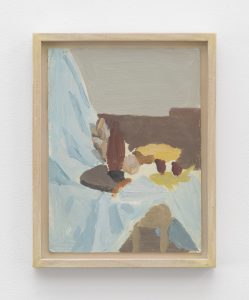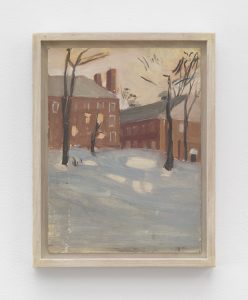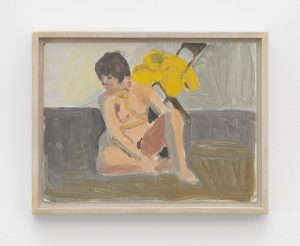In the early 1950s, during the high noon of Abstract Expressionism, the painter Willem de Kooning did something heretical. He started incorporating the recognizable figures of women in his lush, muscular pictures. One fine boozy evening, Clement Greenberg, the don of New York art critics, walked up to de Kooning in the Cedar Tavern and issued what amounted to a fatwa. “You’re dead,” Greenberg told de Kooning. “You can’t paint this way nowadays.”
This decree from on high had an unintended effect on one of de Kooning’s friends and early champions, the figurative painter Fairfield Porter. “I thought, ‘Who the hell is he to say that?’” Porter wrote later. “He said, ‘You can’t paint figuratively today.’ I thought, ‘If that’s what he says, I think I will do just exactly what he says I can’t do! That’s all I will do.’ I might have become an abstract painter except for that.”
 Porter did not become an abstract painter. In fact, he never painted an abstract picture, choosing to avoid the revolving fashions of his age—Abstract Expressionism, Pop, color field painting, Minimalism, Conceptualism—and produce figurative paintings with a rigor and single-mindedness that now make him look nearly heroic. As one critic put it, “Porter was not only a maverick, deliberately out of step with his time, but a heretic, who dissented from the central tenet of the credo of his age.” Rather than tapping into the ferment inside him, Porter painted the world around him as he found it—landscapes, houses, the ocean, people, domestic scenes. Rackstraw Downes, a fellow figurative painter and a sharply perceptive writer on art (and a 2009 MacArthur fellow), describes Porter’s still lifes as “the art of painting whatever was left on the table after breakfast, just as it is.” Porter had a maxim that explains this approach: “When you arrange, you fail.” He added, “An artist who seeks subject matter is like a person who cannot get up in the morning until he understands the meaning of life.” Porter’s concerns, as Downes put it, were “informality and the everyday,” not the formal, the composed, the spectacular. Downes notes that Porter admired Boris Pasternak’s poetry, which spoke to “The endless repetition/Of unrepeatable days.” And so, Porter painted what was in front of him, producing a body of work that amounted to an elegant rebuttal of Clement Greenberg’s claim that it was no longer possible for a figurative painter to say anything new. As Porter said of what motivated him: “When a critic suggests that something is not worth doing because it has been done before, he is in effect urging the artist toward one of the more exciting aspects of art, the attempt to achieve the impossible.”
Porter did not become an abstract painter. In fact, he never painted an abstract picture, choosing to avoid the revolving fashions of his age—Abstract Expressionism, Pop, color field painting, Minimalism, Conceptualism—and produce figurative paintings with a rigor and single-mindedness that now make him look nearly heroic. As one critic put it, “Porter was not only a maverick, deliberately out of step with his time, but a heretic, who dissented from the central tenet of the credo of his age.” Rather than tapping into the ferment inside him, Porter painted the world around him as he found it—landscapes, houses, the ocean, people, domestic scenes. Rackstraw Downes, a fellow figurative painter and a sharply perceptive writer on art (and a 2009 MacArthur fellow), describes Porter’s still lifes as “the art of painting whatever was left on the table after breakfast, just as it is.” Porter had a maxim that explains this approach: “When you arrange, you fail.” He added, “An artist who seeks subject matter is like a person who cannot get up in the morning until he understands the meaning of life.” Porter’s concerns, as Downes put it, were “informality and the everyday,” not the formal, the composed, the spectacular. Downes notes that Porter admired Boris Pasternak’s poetry, which spoke to “The endless repetition/Of unrepeatable days.” And so, Porter painted what was in front of him, producing a body of work that amounted to an elegant rebuttal of Clement Greenberg’s claim that it was no longer possible for a figurative painter to say anything new. As Porter said of what motivated him: “When a critic suggests that something is not worth doing because it has been done before, he is in effect urging the artist toward one of the more exciting aspects of art, the attempt to achieve the impossible.”
 Yet it would be wrong to suggest that Porter’s artistic and literary output was merely a reaction to Clement Greenberg. Porter’s work was much more ambitious and organic than that. A telling glimpse of it is now on view (through May 24) at the Betty Cuningham Gallery in New York. This intimate show is most notable for eight smallish oil paintings on canvas board, never exhibited before, that Porter produced late in life while on a teaching assignment at Amherst College. One of the paintings, characteristically, is the unspectacular view out of Porter’s studio window—a snow-covered slope leading up to brick campus buildings fronted by naked trees. Another is a view across a parking lot to a plush carpet of fall foliage. Both are studies for large, major paintings, and as such they provide a window into Porter’s creative method, the way he worked up ideas.
Yet it would be wrong to suggest that Porter’s artistic and literary output was merely a reaction to Clement Greenberg. Porter’s work was much more ambitious and organic than that. A telling glimpse of it is now on view (through May 24) at the Betty Cuningham Gallery in New York. This intimate show is most notable for eight smallish oil paintings on canvas board, never exhibited before, that Porter produced late in life while on a teaching assignment at Amherst College. One of the paintings, characteristically, is the unspectacular view out of Porter’s studio window—a snow-covered slope leading up to brick campus buildings fronted by naked trees. Another is a view across a parking lot to a plush carpet of fall foliage. Both are studies for large, major paintings, and as such they provide a window into Porter’s creative method, the way he worked up ideas.
 They’re lovely pictures by themselves, but they’re made more lovely by the fact that they are in the act of becoming. The Amherst paintings include a couple of female nudes, plus landscapes and still lifes that verge on the abstract. Rounding out the show are some underworked drawings and a pair of richly worked late paintings—a forest, and a rambling house on a cold spring day—and a portrait of Porter’s son from 1955. The sitter does not look like he’s enjoying himself, but the portrait is a delight.
They’re lovely pictures by themselves, but they’re made more lovely by the fact that they are in the act of becoming. The Amherst paintings include a couple of female nudes, plus landscapes and still lifes that verge on the abstract. Rounding out the show are some underworked drawings and a pair of richly worked late paintings—a forest, and a rambling house on a cold spring day—and a portrait of Porter’s son from 1955. The sitter does not look like he’s enjoying himself, but the portrait is a delight.
 Porter died in 1975 at the age of 68, but it was not until 1984 that he received his first career retrospective, a massive show at the Boston Museum of Fine Arts subtitled “Realist Painter in an Age of Abstraction.” Though he may have been underappreciated during his lifetime, Porter was not exactly unknown. He began exhibiting in the early 1950s, and he was an avid museum- and gallery-goer, producing a large body of insightful writing for ARTnews and The Nation that was collected in the 1979 book Art in Its Own Terms, edited and introduced by Downes. In the estimation of curmudgeonly Hilton Kramer of The New York Times, the book placed Porter “among the most important critics of his time.” It’s hard to argue with the assessment. Reading the book is like hanging out with a tuned-in uncle who knows the score and delights in sharing it with you. Porter wrote effortlessly, voraciously, enthusiastically about artists who were then showing—de Kooning and his wife, Elaine; Jasper Johns; Alberto Giacometti; Jane Freilicher; Joseph Cornell; Isabel Bishop; Alex Katz—and he wrote with equal ease and authority about Cezanne, Rembrandt, Whistler, and his personal favorites, Vuillard and Bonnard. Porter exhibited none of the contempt for abstraction that Greenberg and Company exhibited for figurative art. Porter’s tastes were catholic, free of cant and snobbery. He loved making and looking at art, and his writing makes his love infectious. Here’s a typically clear-eye Porter sentence: “A genuine and ordinary reaction to paintings and sculpture, like one’s first impression of a new person, is usually very much to the point.” Here’s another: “The best criticism is simply the best description.” The clarity of his writing style may have come, in part, from the company he kept: among his close friends were the poets James Schuyler, John Ashbery, Kenneth Koch, and Frank O’Hara. Porter’s wife, Anne, was a finalist for the 1994 National Book Award for poetry.
Porter died in 1975 at the age of 68, but it was not until 1984 that he received his first career retrospective, a massive show at the Boston Museum of Fine Arts subtitled “Realist Painter in an Age of Abstraction.” Though he may have been underappreciated during his lifetime, Porter was not exactly unknown. He began exhibiting in the early 1950s, and he was an avid museum- and gallery-goer, producing a large body of insightful writing for ARTnews and The Nation that was collected in the 1979 book Art in Its Own Terms, edited and introduced by Downes. In the estimation of curmudgeonly Hilton Kramer of The New York Times, the book placed Porter “among the most important critics of his time.” It’s hard to argue with the assessment. Reading the book is like hanging out with a tuned-in uncle who knows the score and delights in sharing it with you. Porter wrote effortlessly, voraciously, enthusiastically about artists who were then showing—de Kooning and his wife, Elaine; Jasper Johns; Alberto Giacometti; Jane Freilicher; Joseph Cornell; Isabel Bishop; Alex Katz—and he wrote with equal ease and authority about Cezanne, Rembrandt, Whistler, and his personal favorites, Vuillard and Bonnard. Porter exhibited none of the contempt for abstraction that Greenberg and Company exhibited for figurative art. Porter’s tastes were catholic, free of cant and snobbery. He loved making and looking at art, and his writing makes his love infectious. Here’s a typically clear-eye Porter sentence: “A genuine and ordinary reaction to paintings and sculpture, like one’s first impression of a new person, is usually very much to the point.” Here’s another: “The best criticism is simply the best description.” The clarity of his writing style may have come, in part, from the company he kept: among his close friends were the poets James Schuyler, John Ashbery, Kenneth Koch, and Frank O’Hara. Porter’s wife, Anne, was a finalist for the 1994 National Book Award for poetry.
 Betty Cuningham was kind enough to give me a tour of the current show when it opened, and we started off talking about Porter’s achievements as a writer. “His wife, Anne, told me that Fairfield thought he was a better writer than painter,” Cuningham said. Then she led me to the wall of pictures from Porter’s Amherst sojourn, and she said, “They’re slow paintings. I think it takes a long time to see him—the richness of the paint, the clarity, the way he works.” I mentioned the affinities between Downes and Porter—accomplished artists and writers, unapologetic iconoclasts—and she said, “They’re painters who know how to express themselves in words. They’re taking you on a trip through the painting—while trying to find their own way. They both go to a painting with tremendous humility.” Finally, I asked her if she thought Porter’s posthumous reputation has finally caught up with his achievements. “Yes, I do,” she said, “I think he is appreciated.”
Betty Cuningham was kind enough to give me a tour of the current show when it opened, and we started off talking about Porter’s achievements as a writer. “His wife, Anne, told me that Fairfield thought he was a better writer than painter,” Cuningham said. Then she led me to the wall of pictures from Porter’s Amherst sojourn, and she said, “They’re slow paintings. I think it takes a long time to see him—the richness of the paint, the clarity, the way he works.” I mentioned the affinities between Downes and Porter—accomplished artists and writers, unapologetic iconoclasts—and she said, “They’re painters who know how to express themselves in words. They’re taking you on a trip through the painting—while trying to find their own way. They both go to a painting with tremendous humility.” Finally, I asked her if she thought Porter’s posthumous reputation has finally caught up with his achievements. “Yes, I do,” she said, “I think he is appreciated.”
 I think—I hope—she’s right. The first signs of a reassessment of Porter were the publication of Art in Its Own Terms and the Boston retrospective. They were followed by a well-received biography by Justin Spring, Fairfield Porter: A Life in Art, which revealed that Porter, despite his privileged upbringing, was no stranger to trauma and misfortune. He was also an avowed opponent of big government, nuclear power, the dehumanizing effects of technology, and, of course, the gospel according to Clement Greenberg. Then came a collection of Porter’s letters edited by Ted Leigh, with an illuminating introduction by David Lehman. And in 2010, the Parrish Museum in Southampton, N.Y., put up a show called “Fairfield Porter: Raw—The Creative Process of an American Master,” a mix of finished, unfinished and abandoned works that revealed how Porter worked. It all adds up to buttress Cuningham’s belief that Porter’s achievement is, at last, appreciated.
I think—I hope—she’s right. The first signs of a reassessment of Porter were the publication of Art in Its Own Terms and the Boston retrospective. They were followed by a well-received biography by Justin Spring, Fairfield Porter: A Life in Art, which revealed that Porter, despite his privileged upbringing, was no stranger to trauma and misfortune. He was also an avowed opponent of big government, nuclear power, the dehumanizing effects of technology, and, of course, the gospel according to Clement Greenberg. Then came a collection of Porter’s letters edited by Ted Leigh, with an illuminating introduction by David Lehman. And in 2010, the Parrish Museum in Southampton, N.Y., put up a show called “Fairfield Porter: Raw—The Creative Process of an American Master,” a mix of finished, unfinished and abandoned works that revealed how Porter worked. It all adds up to buttress Cuningham’s belief that Porter’s achievement is, at last, appreciated.
 Late in the run of the current show, I sat in the gallery and watched people walk in off Rivington Street. They were all shapes and sizes and ages, but I noticed that they all took their time taking in the pictures on the walls. They’re slow pictures. They reward close attention. They’re the work of a heretic who dissented from the credo of is age and, in doing so, gave us art that will last because it is timeless.
Late in the run of the current show, I sat in the gallery and watched people walk in off Rivington Street. They were all shapes and sizes and ages, but I noticed that they all took their time taking in the pictures on the walls. They’re slow pictures. They reward close attention. They’re the work of a heretic who dissented from the credo of is age and, in doing so, gave us art that will last because it is timeless.
from The Millions http://bit.ly/2Wt6bSm

No comments:
Post a Comment